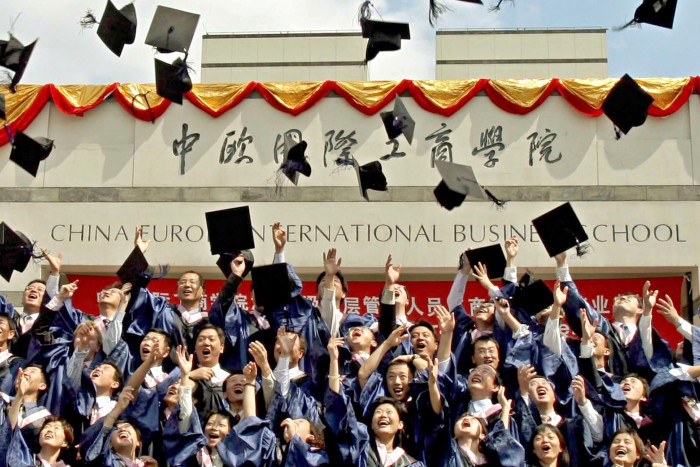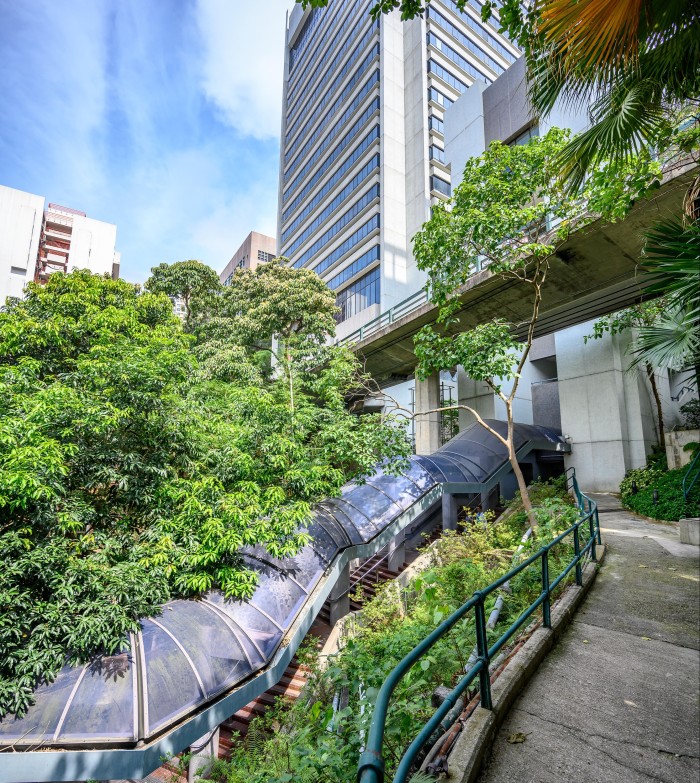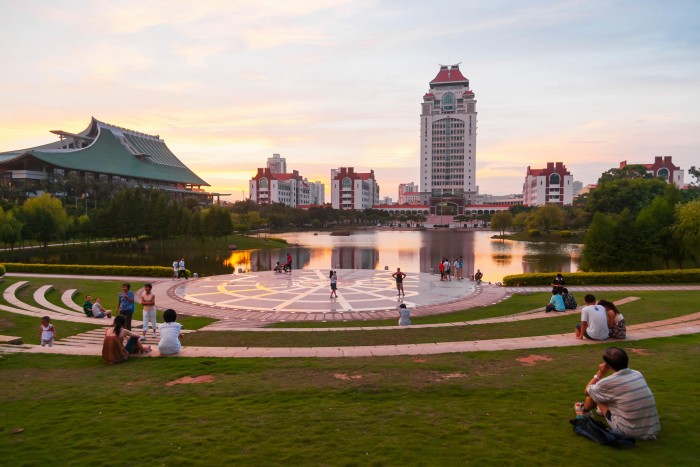FT Executive MBA Ranking 2023: methodology and key

Roula Khalaf, Editor of the FT, selects her favourite stories in this weekly newsletter.
Methodology
This is the 23rd edition of the FT’s annual ranking of the world’s top 100 executive MBA programmes for senior working managers.
Participation in the ranking is voluntary and at the business school’s request. EMBA programmes must meet certain criteria to be eligible. First, the school must be accredited by either the US’s Association to Advance Collegiate Schools of Business or Europe’s Equis.
The EMBA must be cohort-based, with students starting and completing the programme together.
A total of 125 programmes took part in the ranking process, including 13 joint courses delivered by more than one school. Four new schools are featured in the table.
Data for the ranking is collected using two online surveys, the first completed by participating schools and the second by alumni who completed their programmes in 2020. For a school to be eligible for the rankings, at least 20 per cent of its alumni must respond to the FT survey, with a minimum of 20 responses. Due to the effects of the Covid pandemic, the FT considered schools with a lower response rate. The survey was completed by 3,814 alumni — an overall response rate of about 40 per cent.
Alumni responses inform five ranking criteria: salary today, salary increase, career progress, work experience and aims achieved. Together, they account for 50 per cent of the ranking’s weight. The first two criteria concerning alumni salaries count for 33 per cent.
Salaries of full-time students are removed. The remaining salaries are converted to US dollars using the latest purchasing power parity (PPP) rates supplied by the International Monetary Fund. The highest and lowest salaries are then removed and the mean average current salary is calculated for each school. Salary increase is calculated according to the difference in average salary between before the EMBA and three years after course completion. Half of the ranking weight is applied to the absolute increase and the other half to the percentage increase relative to pre-EMBA pay.
If available, alumni criteria are drawn from the past three surveys. Responses from the 2023 survey carry 50 per cent of the total weight and those from 2022 and 2021 each account for 25 per cent. Excluding salary-related criteria, if only two years of data is available, the weighting is split 60:40 if data is from 2023 and 2022, or 70:30 if from 2023 and 2021. For salary figures, the weighting is 50:50 for two years’ data, to avoid inflation-related distortions.
Information provided by the business schools informs 10 criteria that collectively account for 40 per cent of the ranking. The ESG category is based on the proportion of core courses dedicated to environmental, social and governance issues. It carries a weight of 3 per cent.
The weighting for faculty and student gender diversity is five per cent each. For these gender diversity criteria, schools with a 50:50 (male: female) composition receive the highest score.
The international diversity calculation is based on the overall percentage of students and faculty from abroad as well as the spread of these individuals by citizenship based on the Herfindahl index, a measure of concentration.
The final criterion, the FT research rank, accounts for 10 per cent of the ranking. It is calculated according to the number of articles published by schools’ full-time faculty in 50 internationally recognised academic and practitioner journals. The rank combines the absolute number of publications from January 2020 to about May 2023 with the number of publications weighted relative to the faculty’s size.
The FT rankings are relative. Schools are ranked against each other rather than against set standards. The FT calculates the Z-scores for each criterion. Z-scores show how far a school’s data is from the mean and are unitless, so they allow the ranking to be based on very different criteria — salary, percentages and points. These scores are then weighted as outlined in the ranking key and added together for a final score.
After removing the schools that did not meet the minimum response rate from their alumni, a first version is calculated using all remaining schools. The school at the bottom is removed and a second version is calculated. This action is repeated to find the top 100.
Key (weights for ranking criteria are shown in brackets as a percentage)
Salary today US$ (16): average alumni salary three years after course completion, US$ PPP equivalent.†#
Salary increase (17): average difference in alumni salaries between before the EMBA and now. Half of this measure is calculated according to the absolute salary increase and half according to the percentage increase relative to the pre-EMBA salary — this is the figure published in the table.†#
Career progress (6): calculated according to changes in the level of seniority and the size of the company or organisation alumni work in now versus before their EMBA.†#
Work experience (5): a measure of the pre-EMBA experience of alumni according to the seniority of positions held, number of years in each position, organisation size and overseas work experience.†#
Aims achieved (6): the extent to which alumni fulfilled their goals or reasons for doing an EMBA.†#
Female faculty (5): percentage of full-time female faculty.‡
Female students (5): percentage of female students on the programme.‡
Women on board (1): percentage of female members of the advisory board.‡
International faculty (5): calculated according to the diversity of faculty by citizenship and the percentage whose citizenship differs from their location of employment — the published figure.
International students (6): the percentage of current EMBA students whose citizenship differs from the location in which they study, or where the school’s main campus is located, as well as their diversity by citizenship.
International board (1): percentage of the board whose citizenship differs from the location in which the business school is situated.
International course experience rank (5): based on the percentage of classroom teaching hours, for the recent completing class, that were conducted outside the location in which the business school is situated. In-person, virtual and hybrid experiences are included.
Faculty with doctorates (5): percentage of full-time faculty with a doctoral degree.
FT research rank (10): calculated according to the number of articles published by a school’s current full-time faculty members in 50 academic and practitioner journals from January 2020 to about May 2023. The rank combines the absolute number of publications with the number weighted relative to the faculty’s size.
ESG and net zero teaching rank (3): proportion of teaching hours from core courses, for the recent class, dedicated to environmental, social and governance issues and climate solutions enabling organisations to reach net zero.
Carbon footprint rank (4): calculated using the net zero target year for carbon emissions set by the university and/or school, and the existence of a publicly available carbon emissions audit report since 2019.
Overall satisfaction: average course evaluation by EMBA alumni, scored out of 10.
FT ranking tier: schools are divided into four groups. Schools at the top are in tier l and those at the bottom are in tier lV.
† Includes data for the current year and the one or two preceding years where available.
‡ For the three gender-related criteria, schools that have 50:50 (male:female) composition receive the highest possible score.
# Data from alumni who completed their programmes in 2020 included.
Judith Pizer, of Pizer-MacMillan, and Avner Cohen acted as the FT’s database consultants. The FT research rank was calculated using Clarivate data covering 50 journals selected by the FT from the Web of Science, an abstract and citation database of research literature.
Top EMBA: Kellogg/HKUST

Kellogg/HKUST retains the number one spot, partly because its alumni reported the highest average salary at $652,326. This joint programme run by the US and Hong Kong business schools has taken top place 12 times since the launch of the EMBA ranking in 2001. Despite dipping significantly for career progress to 57th place, measured by changes in alumni job seniority and employer size, the EMBA received a high overall satisfaction score at 9.64.
Top solo EMBA: Ceibs

In second place, the Shanghai-based school retains its position as the highest ranking EMBA offered by a single provider. Three in four graduates fulfilled their goals for studying for an EMBA. They also received the second-highest average salary, at $529,822, with an average increase of 88 per cent. Alumni commended the international experience of the programme, the network opportunities and Ceibs’ locations, with campuses in Europe and Africa.
Top for overseas experience: ESCP Business School

In third place overall, multi-campus ESCP is ranked top for international course experience: a measure of the percentage of classroom teaching hours completed outside the school’s location. In addition to exposure to diverse working and teaching cultures, students also receive a strong education in ESG, for which ESCP is ranked second. Alumni described the course as a transformational experience.
Top 10 again: Oxford: Saïd

The EMBA at the University of Oxford’s Saïd Business School — last in the top 10 in 2019 — is ranked fifth. Alumni experienced a 90 per cent salary increase, on average, between before the EMBA and now, and praised the management capabilities gained. “The programme enabled interactions and deep social connections with other leaders, which greatly influenced both my personal and professional development,” said one alumnus.
Top for salary increase: HKU Business School

Ranked 24th, HKU Business School alumni reported an average salary increase of 110 per cent from before their EMBA to now — the biggest rise for the second year running. The Hong Kong school also improved its position in the research rank, from 29 to 16. Alumni rate the faculty and the EMBA network highly. One executive said: “The programme played a crucial role in expanding my professional network, both within and beyond my industry.”
Biggest riser: Neoma Business School

The French school leaps 32 places to 46, the biggest riser in the EMBA ranking. Alumni praised the study trips abroad, the school’s engaging professors and the supportive alumni network. Neoma is 14th in the new carbon footprint rank, based on factors including its net zero target year for carbon emissions. The school also has 95 per cent of full-time teaching staff from overseas, the third-highest in the table.
Highest new entry: Xiamen

Xiamen University School of Management in China is the highest new entrant, in joint 65th place. Its placing can be attributed partly to the second highest alumni salary increase — of 109 per cent — from before the course to now. Xiamen also performed well in the ESG category, ranked 23rd, measured by the number of hours devoted to the topic in the programme’s core courses for the recent class.
Top for ESG: IE Business School

Some business schools are showing the way on ESG and sustainability issues. In sixth place overall, Spain’s IE Business School is one of the leading institutions when it comes to teaching ESG and this is reflected in the EMBA table, where it is ranked first for the category. Alumni noted that ethics and ESG were emphasised in all modules, not only those with a specific focus on these topics.
Facts about the top 25 schools
Rank 1
Kellogg/HKUST tops the table for the second year running, in part due to the high average salaries of its alumni.
Rank 3
France’s ESCP is ranked highest for the proportion of course hours taught overseas.
Rank 4
The joint Trium EMBA has the alumni with the greatest work experience pre-EMBA, based on seniority, employer size and overseas employment.
Rank 5
Alumni of Oxford: Saïd reported achieving the highest proportion of their aims for starting an EMBA.
Rank 6
Spain’s IE includes the most core course hours on environmental, social and governance content.
Rank 10=
Iese in Barcelona has the most international students, with 98 per cent of the class from overseas.
Rank 10=
Yale is one of two schools to report 50:50 gender balance in its most recent EMBA cohort.
Rank 14
IMD has the highest proportion of international faculty, with 98 per cent from overseas.
Rank 17
Chicago: Booth tops the research rank, based on the volume of articles published in selected journals, weighted by the school faculty size.
Rank 24
HKU’s alumni have the highest salary increase, of 110 per cent, from before the MBA to now.
By Sam Stephens
Criteria for taking part in our ranking
Updated on May 10, 2023
We review the criteria on a regular basis. The pandemic has affected business schools and our ranking process, but we have done our best to accommodate feedback from schools. Please note, we are unable to include requests from every school.
The FT EMBA ranking is based on two surveys: one for the business school and one sent to your alumni who completed their EMBA three years ago.
Each school can only submit one standalone programme. However, more than one programme can be submitted if the additional programme is a joint degree. Joint programmes can be separately entered, on condition they are structured so that participating students take classes from all partner institutions in the programme.
The following are the criteria schools must meet in order to participate in the annual EMBA ranking:
The business school must be accredited by AACSB or Equis.
Your programme must have been running continuously for the past four years and the first class should have graduated in the calendar year at least three years prior to the survey date.
Executive MBAs are part-time degrees designed for senior working managers. It is assumed most participants have at least 10 years of work experience and hold managing positions.
The course of study should last no longer than three years. This is the default length. If your EMBA graduates took more than 3 years of study then they cannot take part in the survey, therefore they should be removed from the list of alumni to be surveyed.
Students must matriculate and graduate in cohort(s).
We usually ask for at least 30 students to have completed the programme, per year, three years ago and in each subsequent year. But, if the running of your nominated programme (for this year’s ranking) was disrupted by the pandemic, we understand that your school may not meet criterion number 6. In this case, we ask for at least 25 students to complete the programme in either year 2021 or 2022. Your school can take part in this year’s ranking as long as your school meets the rest of the criteria. This year we are surveying graduates who completed your nominated programme 3 years ago, but we require at least 30 alumni to have completed your programme in the calendar year 2020.
No more than 20 per cent of the class must be from one company. Subsidiary companies of a group are treated as separate companies.
The business school must have a minimum of 20 full-time permanent faculty.
Graduates need to complete the survey in English.
Ideally, business schools should be able to supply the email addresses of all its alumni who completed their programme three years ago. These will be used purely for editorial research purposes and held securely and destroyed after use, unless they agree for us to contact them again for future research, respecting GDPR and the FT rankings privacy policy: https://bschoolportal.ft.com/privacy-policy Please exclude those who want to opt out of our survey. Please do not select and lobby alumni to complete the survey.
We need a response rate of at least 20 per cent from alumni with a minimum of 20 completed surveys from any school wishing to be considered for the ranking. E.g., a class size of 100 graduates will require 20 completed surveys and a class size of 200 alumni will require 40 completed surveys. This response rate is based on the total size of the cohort we are surveying, not the number graduate emails you will be able to supply, as we are aware that some alumni will opt out of the survey.
Meeting these criteria does not guarantee automatic participation in the ranking. The final decision rests with the Financial Times.
Please note, the table is finalised about eight weeks before the publication date. It is too late for schools to withdraw from the ranking after the eight-week mark.
Email emba@ft.com by the start of March if you have questions or wish to take part as the ranking process starts in mid-April. By this time, the onus is on schools to get in contact with us if they wish to take part in the ranking, as we are unable to email every single school to check if they wish to be considered.
Rankings: https://rankings.ft.com
Report: http://www.ft.com/emba
Methodology: https://www.ft.com/emba-method
Timings
Invitation to participate: April/May
Schools to confirm participation: May
Schools to upload alumni list: May
Schools to upload faculty list: July
Survey open: June
Survey close: June/July
Data checks with schools: July – September
Publication: October

Comments